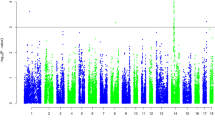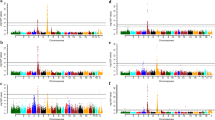Abstract
Anal atresia (i.e., anorectal malformations) is a severe disorder that occurs during the development of the distal hindgut in infants, swine, and many other mammals and has an unclear genetic background. Recently, the Shh-responsive transcription factor GLI2 has been shown as essential to the normal development of the hindgut, and QTL studies in pigs revealed that this gene may be an important candidate for anal atresia (AA). We used the pig as the model to study the contribution of GLI2 to AA. We revealed the genomic structure of the porcine GLI2 gene with 14 exons and obtained the porcine GLI2 mRNA sequence with a 4,656-bp ORF coding a 1,551-amino acid protein. We further scanned the genome-wide mutations in this gene by direct sequencing using three genomic DNA pools from the AA pigs, full-sibs of AA pigs, and unaffected pigs, respectively. Finally, 30 single nucleotide polymorphisms (SNPs) and one intronic 9-nucleotide (nt) deletion were identified. Of these SNPs, 23 are intronic, 6 are synonymous, and 1 (446 G>A) in exon 8 is nonsynonymous (365Met >Ile). NCOI-RFLP of the 446 G>A polymorphism suggested that the predominant genotypes were all GG and AG in the three pig groups. In addition, there was no significant difference among the three groups in allele frequencies, which demonstrated that this locus was not associated with AA in pigs. However, the 12 SNPs encompassing exon 4 to exon 8 showed strong linkage disequilibrium in the AA pigs, which indicated that the mutations somewhere in this region may contribute to AA in pigs. Therefore, further investigation in this region is needed to elucidate the underlying mutations involved in the porcine AA.


Similar content being viewed by others
References
Bai CB, Auerbach W, Lee JS, Stephen D, Joyner AL (2002) Gli2, but not Gli1, is required for initial Shh signaling and ectopic activation of the Shh pathway. Development 129:4753–4761
Bai CB, Stephen D, Joyner AL (2004) All mouse ventral spinal cord patterning by hedgehog is Gli dependent and involves an activator function of Gli3. Dev Cell 6:103–115
Cassini P, Montironi A, Botti S, Hori T, Okhawa H, Stella A, Andersson L, Giuffra E (2005) Genetic analysis of anal atresia in pigs: evidence for segregation at two main loci. Mamm Genome 16(3):164–170
Hori T, Giuffra E, Andersson L, Ohkawa H (2001) Mapping loci causing susceptibility to anal atresia in pigs, using a resource pedigree. J Pediatr Surg 36:1370–1374
Hughes DC, Allen J, Morley G, Sutherland K, Ahmed W, Prosser J, Lettice L, Allan G, Mattei MG, Farrall M, Hill RE (1997) Cloning and sequencing of the mouse Gli2 gene: localization to the Dominant hemimelia critical region. Genomics 39:205–215
Ingham PW, McMahon AP (2001) Hedgehog signaling in animal development: paradigms and principles. Genes Dev 15:3059–3087
Khoury MJ, Cordero JF, Greenberg F, James LM, Erickson JD (1983) A population study of the VACTERL association: evidence for its etiologic heterogeneity. Pediatrics 71:815–820
Kimmel SG, Mo R, Hui CC, Kim PC (2000) New mouse models of congenital anorectal malformations. J Pediatr Surg 35(2):227–230 discussion 230–231
Mo R, Kim JH, Zhang J, Chiang C, Hui CC, Kim PC (2001) Anorectal malformations caused by defects in sonic hedgehog signaling. Am J Pathol 159(2):765–774
Motoyama J, Liu J, Mo R, Ding Q, Post M, Hui CC (1998) Essential function of Gli2 and Gli3 in the formation of lung, trachea and oesophagus. Nat Genet 20:54–57
Roessler E, Ermilov AN, Grange DK, Wang A, Grachtchouk M, Dlugosz AA, Muenke M (2005) A previously unidentified amino-terminal domain regulates transcriptional activity of wild-type and disease-associated human GLI2. Hum Mol Genet 14(15):2181–2188
Sasaki H, Nishizaki Y, Hui C, Nakafuku M, Kondoh H (1999) Regulation of Gli2 and Gli3 activities by an amino-terminal repression domain: implication of Gli2 and Gli3 as primary mediators of Shh signaling. Development 126:3915–3924
Speek M, Njunkova O, Pata I, Valdre E, Kogerman P (2006) A potential role of alternative splicing in the regulation of the transcriptional activity of human GLI2 in gonadal tissues. BMC Mol Biol 7:13
Stevenson RE, Hall JG, Goodman RM (eds) (1992) Human malformations and related anomalies. Oxford University, New York, pp 493–499
Stoll C, Alembik Y, Roth MP, Dott B (1997) Risk factors in congenital anal atresias. Ann Genet 40:197–204
Tanimura A, Dan S, Yoshida M (1998) Cloning of novel isoforms of the human Gli2 oncogene and their activities to enhance tax-dependent transcription of the human T-cell leukemia virus type 1 genome. J Virol 72(5):3958–3964
Thaller G, Dempfle L, Hoeschele I (1996) Investigation of the inheritance of birth defects in swine by complex segregation analysis. J Anim Breed Genet 113:77–92
Acknowledgments
This work was financially supported by the National Natural Sciences Foundation of China (31000995), the Natural Sciences Foundation of Hubei Province (2010CDB10106), and Science Foundation for The Excellent Youth Scholars of the Ministry of Education of China (20100146120025). We also thank Xianbo Zhang for collecting the experiment materials.
Author information
Authors and Affiliations
Corresponding author
Additional information
Qiushi Jin and Chao Wang have contributed equally to this work.
Electronic supplementary material
Below is the link to the electronic supplementary material.
Rights and permissions
About this article
Cite this article
Jin, Q., Wang, C., Li, X. et al. Molecular characterization and genome-wide mutations in porcine anal atresia candidate gene GLI2 . Mamm Genome 24, 500–507 (2013). https://doi.org/10.1007/s00335-013-9485-8
Received:
Accepted:
Published:
Issue Date:
DOI: https://doi.org/10.1007/s00335-013-9485-8




